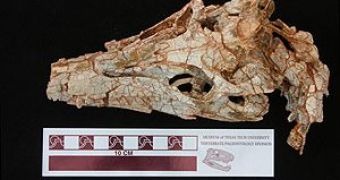Researchers from the Museum of Texas Tech discovered and identified what is believed to be the oldest crocodile ancestor ever to be found.
It seems that the animal lived in the tropical rainforests of West Texas, which scientists say that it looked more like Costa Rica, some 225 million years ago.
Sankar Chatterjee, curator of paleontology at the Museum of Texas Tech said that today we probably wouldn't recognize its body, since it was built more for running on land rather than for swimming.
But once the scientists saw its eyes and the head, they realized that they were looking at possibly the oldest crocodile ancestor that was ever found.
Chatterjee explained that this newly discovered crocodile ancestor lived about the time that dinosaurs started to evolve.
Its hind limbs, along with its hip girdle and tail suggest this was a land animal, and the bones prove that it was adapted to walking or running.
The crocodiles we see today have small legs and a tail which allows it to swim and move very fast in water.
The biggest similarities between the two lie in the ankle joint and braincase, Chatterjee explained.
“It has lots of sinuses in the braincase like those of modern crocs; these sinuses may be linked to their vocalization.
“Unlike most reptiles, crocs are very vocal and hear well.
“We described a similar animal from China that gives us some idea about the way this animal lived.
“Leaving land for the water was probably the smartest thing crocodiles and alligators did; that way, they didn’t encounter the dinosaurs like other animals did.”
This fossil was discovered on a ranch and then was prepared by Doug Cunningham, fossil preparator at the Museum of Texas Tech.
With Texas Tech’s Department of Petroleum Engineering's new CT scan, Chatterjee was able to look inside the animal's skull and study the brain case and sinus cavities.
According to Shameem Siddiqui, the Kerr-McGee Professor of Petroleum Engineering, who worked with Chatterjee on the project, this CT is usually used to study fluid flow through different types of rocks.
But it can also be used to image fossilized bones, so this was the perfect opportunity to learn more about the crocodile.
“This is a brand new animal and possibly the great-grandmother of all crocodiles,” Chatterjee said.
“It was still walking; these early crocodiles look like your typical terrestrial animals.
“An intact skull is very rare to find.
“One of the exciting things is we were able to see inside its brain case with the CT scan.
“We can see the brain evolved very slowly.”
Siddiqui said that once the skull was scanned, the researchers were “able to find some hidden pieces of the crocodile.
“That was exciting. When we did the 3-D imaging of the skull, it was equally as exciting.
“Already, Sankar and I have been talking about using the CT scanner to measure bone density of more recent crocodiles and compare the data with bone densities of this ancient crocodile.”
According to Chatterjee, he has yet to name the animal, but this ancient reptile probably won’t debut in scientific literature for another two years.

 14 DAY TRIAL //
14 DAY TRIAL //